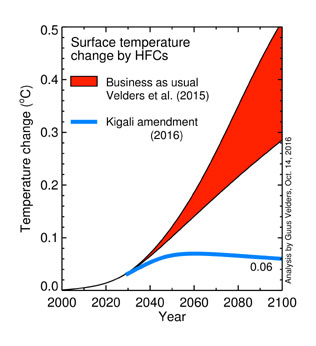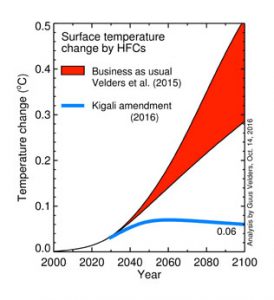In another historic day for people who understand the urgency of addressing climate change, the world has agreed to a binding agreement to phase out HFCs.
As we’ve written many times before, this one move can shave off 0.5°C (1°F) of global warming – huge in terms of the ultimate goal of keeping temperatures from rising more than 1.5°C. It is the first concrete step toward meeting the goals of the Paris Climate Agreement.
“Concrete global action at scale has begun, and we are not turning back,” says Hakima El Haite, Minister of Energy, Water, and Environment for Morocco.
Under the Kigali Agreement, HFC levels in the atmosphere will be cut 80-85% by 2047.
The deal is equivalent to eliminating double the world’s carbon emissions produced every year – an astounding 70 billion tons of pollution.
HFCs are extremely powerful “climate forcers” – 10,000 times more potent than carbon dioxide in trapping heat in our atmosphere. When the Montreal Protocol successfully dealt with the problem of the ozone hole in 1987, HFCs were viewed as a safer alternative to CFCs, which were causing the hole. At the time, no one knew HFCs were a potent greenhouse gas.
Now, HFCs are the fastest-growing source of climate-changing emissions, increasing about 10% a year. As the middle class grows and the world swelters from increasingly hot temperatures, demand for air conditions is expected to soar 72%.
Unlike carbon dioxide emissions, which remain in the atmosphere for centuries, climate forcers only hang around for short periods, so eliminating them makes a big difference fast.
The Kigali Amendment
170 countries met all last week in Kigali, Rwanda to reach agreement under the Montreal Protocol on phasing out HFCs.
Unlike the Paris Climate Agreement, which had to be voluntary so that US Republicans couldn’t block it, the Montreal Protocol is mandatory because the Senate ratified it during the Reagan Administration.
That means that while future leaders (ie, Trump) can pull out or change their commitments under the Paris Agreement, the Kigali Agreement specifies goals, timetables and enforcement mechanisms.
Also unlike Climate Summits, where countries argued for decades over “who should go first”, this agreement clearly puts the onus on advanced nations to do the upfront work.
Since HFCs are used mostly for refrigeration and air conditioners, many developing countries are just starting to use them and with the heat of global warming devastating their citizens, they insisted on being allowed more time to meet the goals. So, like most international agreements, Kigali is a compromise.
- In 2018, advanced nations will freeze production and consumption of HFCs, reducing them to about 15% of 2012 levels by 2036.
- Over 100 countries will implement a freeze by 2024, reducing HFCs to 20% of 2021 levels by 2045.
- A handful of the world’s hottest countries – India, Pakistan, Iran, Saudi Arabia and Kuwait – will begin the process in 2028 and reduce use to 15% of 2025 levels by 2047.
- All countries must cut HFC consumption by at least 80% by 2047.
- Advanced nations will finance research on HFC substitutes and assist countries in need with financing.
It sends a strong market signal to corporations that innovation on product development will be rewarded and the chemical industry, one of the major antagonists on climate regulations, were in Kigali advocating for the deal. They are already working hard on HFC alternatives, they say.
Obama Administration Did the Ground Work
President Obama, John Kerry and Hillary Clinton deserve congratulations for working tirelessly over his term to find this global solution. Obama paved the way when he was able to bring China on board in 2013. China – the largest producer of HFCs in the world – agreed to make their elimination a priority. Obama also brought Brazil into the fold.
This summer, the US, Canada and Mexico agreed to work together to get the Kigali Agreement.
Under the Clean Energy Ministerial, another Obama Administration initiative, the world’s most polluting countries are participating in the Advanced Cooling Campaign. It challenges governments and industry to develop and scale super-efficient, affordable cooling technologies. The goal is to improve efficiency 30% by 2030.
Major air conditioning manufacturers are involved, such as Ingersoll Rand, which plans to spend $500 million on R&D and Honeywell, which says it’s spending $900 million on research and manufacturing capacity in the next few years.
On October 6, the Paris Climate Agreement entered force and on October 7, the world signed an agreement to begin cap-and-trade for the aviation industry, another major source of rising emissions.
Read our article, Lessons From the Ozone Hole, Movement on Global HFC Phase-Out.


